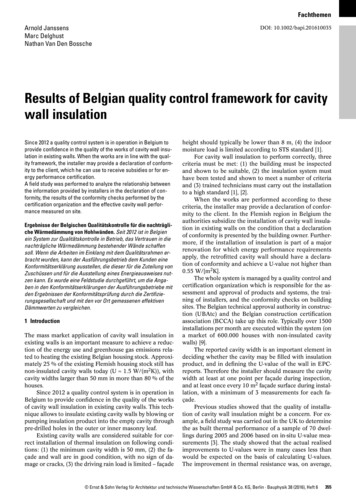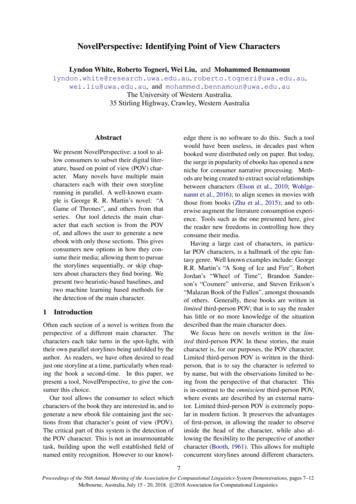
Transcription
Belgian MalinoisTraining SecretsMark Mendoza
ContentsBelgian Malinois Breed Profile 3Obedience Training: A Belgian Malinois Owner’s Guide 6How to Stop the 10 Most Common Belgian Malinois ObedienceProblems A 7-Step Housetraining Guide for Your Belgian Malinois Conclusion 2165360
Belgian Malinois Breed ProfileBelgian Malinois Dog BreedThe Belgian Malinois dog is a loyal watchdog, smart,intelligent, and a proud member of the Herding Group, with ahistory that goes back to the early 1800s. This breed standstall and poised on alert, always ready to guard and protect itsfamily and territory. They have the physical appearance of amuscular, yet elegant canine, with the overall impression oflean power and an inquisitive expression in its face.The temperament of the Belgian Malinois can best bedescribed as a high-energy dog breed that is reserved aroundstrangers, yet as playful as they come around its family. Theyare great around children and moderately friendly towardsother dogs and pets in the house. The Belgian was born andbred to be a guard dog so they tend to have a dominatingpersonality that must be trained by the right type of owner.A Brief History Of The Belgian Malinois3
As the name of this breed suggests, the Belgian Malinois hasits roots from Belgium during the 1800s. The original Belgiansheep herding dog breeds were known as Chiens de BergerBelge and were used as all-purpose service dogs, mainly toguard livestock. They were strictly working dogs that werebred for ability over appearance.During this time period, there were many different varieties ofBelgian working dogs, thus it was hard to know if anyrecognizable breeds could be found within the groups. In1891, a man named Professor Reul began studies of thesenative dogs and found a specific variety that had a short coatand was developed in a location around Malines. These dogsbecame known as the Belgian Malinois.The breed has remained incredibly popular in its native landof Belgium but not so much in the United States. After WorldWar II, the Belgian Malinois had rapidly declined in numbersthroughout America but has since become one of the mostprominent police service dogs throughout the world.Upkeep Requirements For The Belgian Malinois4
Being the proud owner of the Belgian Malinois means enjoyingan active lifestyle, spending plenty of time outdoors. This isone breed that is not meant to sit inside a small apartment allday. They need to have vigorous play sessions in the yard andexpend energy through sprints or fast-paced jogs with itsowner. It especially enjoys herding when given the chance.Living arrangements for the Belgian Malinois should be set upso that the dog has access to a safe, fenced-in area outsideduring the day, preferably a large yard with shade. At night, itis best suited to sleep indoors with the rest of the family.They have tolerance to moderately cool and warmtemperatures. Grooming requirements call for a light brushingabout once per week to remove dead hairs.Health ConcernsThe average lifespan of the Belgian Malinois is between tenand twelve years. There are no major health concerns thatrun common in the breed. Minor health issues include elbowdysplasia and CHD. Rarely seen is cataracts, PRA,hemangiosarcoma, and pannus. Veterinarians suggest that5
Belgian Malinois dogs get specifically tested for eye, hip, andelbow problems.6
Obedience Training: A Belgian MalinoisOwner’s GuideA lot of dog owners often complain about their BelgianMalinois’s uncontrollable behavior and find themselves at aloss as to how to properly teach their highly spirited commands such as ‘sit’ and ‘stay’ can crucially become amajor problem in the future with the possibility of your oncepesky dog to become a family pest or even worse aneighborhood nuisance.Hence, it makes it all the moreimperative for Belgian Malinois owners to teach their preciousdogs obedience lessons before it’s too late.Obedience training, in essence should not be treated as ameans to teach your Belgian Malinois to do fancy tricks ience training is to simply teach obedience and basicallyteach them to follow simple commands. Before anything else,family should be carefully inculcated to your Belgian Malinois,as this will vitally ensure harmonious cohabitation for years.While other dog owners prefer to send their dogs to obedienceclasses, any dedicated dog lover can actually do this at thecomforts of their own home. This will provide more time for7
n skills. Obedience training basically requires ahealthy dose of patience, a collar and a leash, lots of sense ofhumor and a keen understanding to the natural BelgianMalinois behavior. For people who never had any priorexperience with raising dogs, it might be more helpful to readbooks about the particular breed they own to fully grasp thedog’s behavior.Age MattersSo what would be the best time for train your BelgianMalinois?Experts claim that’s its highly recommended to train them asearly as 8 weeks old. The old adage “you can’t teach old dogsnew tricks” may have a grain of truth to it, to some extent.This is mainly because like human beings, as dogs age themental abilities also diminishes, which predictably have agreat impact on efficacy of the training. It is also said thatafter three months, dogs have more or less established theirunique behavior that can be quite hard to eliminate in place ofnewer ones.Understanding the Canine Psyche and Learning Styles8
The unique about dogs is the fact that unlike the othermembers in the animal kingdom, canines take more pleasurein learning and performing. Of course, the level of intelligencevary from certain breeds, but more often than not dogs ingeneral display a better response in learning new things. ForBelgian Malinois owners, it can be equally stimulating and athoroughly enjoyable experience.However, don’t fall in the mistake of assuming that trainingdogs as similar to teaching children. This is simply not thecase. Why? For one, canines are entirely different specie andtheir differences from man doesn’t’ just end in the physicalaspect. Keep in mind that things are wholly different fromyour dogs’ point of view. Dogs have limited field of vision,which can be a hindrance in the obedience training. While wecan easily see objects on a seemingly bird’s eye view, yourdogs line of vision are what might seems like clutteredobjects, such as chairs and doors they cannot open.Another important thing to keep in mind is the fact that dogshave a keen sense of smell and hearing, which can play amajor advantage in calling out commands as well as becomea source of distractions too. While you are busy teaching yourBelgian Malinois, he may pick on certain sounds such as thestarting of a car engine, which definitely poses as a majordiversion. The great thing is if you have a treat well hidden inyour pocket, your dog can easily pick out that smell; this can9
undoubtedly work on your advantage and cajole him inbecoming more attentive.In fully understand the canine psyche, humans have toacknowledge can dogs too know how to communicate – albeitin an entirely different language. So if you pay carefulattention to their barks, whines, yowls and growls you canmore or else distinguish and understand what they want totell you. The different sounds they make are usually goodindicator of their mood and any other form of expression.Like pre-school children, dogs often display an adorableeagerness to learn. They may not appear to prefer what youteach them, but at they end of the day they will be able topick out a thing or two after every training session.Training BasicsThe basic requirement for obedience training is a six-footleash made of either nylon or leather. Experts don’t usuallyrecommend the use flexi or retractable leases for training.You will also need a sturdy collar that should be fittedproperly. Always keep handy some treats or toys to use asreward for your dogs and lots of water, too. For BelgianMalinois owners, you need to have a steady stream ofpatience coupled with a highly positive attitude. Dogs can10
sense your moods, whether you are tense or properly relaxed,and will predictably respond accordingly.It is equally important to choose the area that has limiteddistractions so your Belgian Malinois will find it easier to focuson whatever task at hand. Keep in mind that the younger theBelgian Malinois, the shorter should be the training session. Atypical session should be a maximum of two to three sessionsin a day and each session should not exceed more than five toten minutes in length. If you notice that your Belgian Malinoisis not feeling well, schedule the training session for later asthis will only give you and your Belgian Malinois a hard time.Some experts recommend training dogs when they arehungry mainly because you can easily use food treats considerably be more agile and more willing to please.Basic CommandsSit/Stay – for this session, your Belgian Malinois shouldbe on a leash in front of you. Carefully hold a treat above hishead and give the command in a clear voice ‘sit’. By forcingyour Belgian Malinois to look up to the treat, he will need tosit on his rear end. Then slowly the treat in the direction of his11
tail to force him to adapt a complete sitting position. Be readyto repeat this command several times until such time yourBelgian Malinois will sit properly. Do not forget to providerewards and praise whenever he responds correctly.Come – This command should be taught early in orderfor your Belgian Malinois to easily recall this particular orderall throughout his lifetime. Treats are also used to lure yourBelgian Malinois to come to you. Start with placing a dry foodon a plastic container then show it to your Belgian Malinoiswhile clearly saying the word ‘treat’. This will help yourBelgian Malinois associate the sound of shakers (meat inplastic) with treats. Do this as often as needed until such timeyour Belgian Malinois will visibly respond to the sound of theshaker.After a few sessions use the shaker to call him towards you.But this time be sure to call out the word ‘come’ before usingthe shaker. If your Belgian Malinois responds correctly, givehim a treat. In time your Belgian Malinois will learn toassociate the word come with a shaker, that’s the only timeyou start to gradually increase your distance. Make sure thatyou will not call your Belgian Malinois to reprimand him, as12
this will only cause negative reactions every time you call himin the future.Down – begin with your Belgian Malinois on a sittingposition and use the treat to lure him to bend halfway to theground. Slowly move your hand closer to the ground and oncehe starts to understand, gently move the food away. Do thisfor several repetitions until he can easily move his headtowards the ground. After having achieved that, try to movethe lure under his chest and wait for a few seconds. At thispoint, would readily learn to drop. Exercise later without thebait to get him to cooperate.Heel – for dog owners, it can be quite exasperating tohave an untrained Belgian Malinois on a leash moving along avery busy sidewalk. It can be a perfect recipe for disaster,especially if there is another Belgian Malinois in sight.Untrained dogs are more likely to crisscross, trip other peopleand practically become a walking pest and peril. Teachingyour dog to heel is one of the most essential commands inorder to instill some disciple especially if you are out onpublic.13
Like other commands, this is taught using a leash. From thesit/stay position, allow your Belgian Malinois to warm up bygiving him free rein to rum. Then command him to sit/stay onyour left side and firmly grasp the leash halfway between theBelgian Malinois and your right hand. This will provide you acorrective hold when needed. Call out clearly the command‘Heel!’ with the Belgian Malinois’s name. For example, “Hell,Chuck!’ As you give out the command, move with your leftfoot first. Your Belgian Malinois will either dash forward or lagbehind. These are among the expected reactions. This is whenyou need to make some corrective and instantaneousreactions. If he tries to dash, let him do so but only until atthe need of the leash, then yank hard. Walk up to him andcommand ‘sit/stay’, then praise or pat him on the head. If helags behind, don’t try to drag him but instead wait for him tocome along with you, gently using the leash to urge him on,then make him sit or stay. Do not forget to praise him or givethe reward after every command.Once your Belgian Malinois learns how to heel with the leash,teach him to be on a sitting position once you stop walking.Walking him in a short distance, then stop and give out theheel command or signal him to sit. You need to keeprepeating this walk and sit routine until such time you neednot call out a command but simply use hand signals.14
Rewards and ReprimandsThe most important part of any obedience training isproviding rewards to your Belgian Malinois on an especiallygood and cooperative behavior. Studies have shown thatrewards promote quicker learning methods as food beingconsidered as the primary incentive. It is therefore importantall throughout the obedience training to repeatedly setsituations to practice and get treats as rewards. Praise andreward are important to always maintaining proper BelgianMalinois behavior and prevent attitude problems from arisingin the future.In their daily lives, dogs are often bombarded with stringentcommands such as ‘NO’, ‘STOP’, ‘BAD BELGIAN MALINOIS,which ultimately tends to become meaningless and are oftenignored. Whenever you find the great need to reprimand yourBelgian Malinois, it would be a more effective approach toshow him immediately what you want him to do and rewardhim if he gets it right. That would be a more constructiveapproach. For example, if you find him gnawing at a piece ofyour furniture, tell him ‘OFF’ right away, and immediately leadhim to his toys and encourage him to chew on them instead.Don’t forget to praise him or give a treat for doing so.15
If a reprimand is done correctly, your voice will be sufficientenough as a command. The best way to address a reprimandis to keep it short, sharp and immediate. It would prove to bequite futile to nag at your Belgian Malinois, as they will notunderstand you at all. Never reprimand him if you don’tactually catch him on the act. A lot of animal expertsadamantly discourage hitting, slapping, kicking or spankingdog dogs. This is simply an inappropriate punishment and willonly create more problems or worsen existing problems in thefuture. You wouldn’t want your Belgian Malinois to growoverly timid or fearful, right?A Lifetime CommitmentEvery dog owner should rightfully acknowledge that learningfor dogs that not simply end in a few weeks of trainingclasses. It should be a life long learning experience both forthe Belgian Malinois and the dog owner.Raising a BelgianMalinois should be viewed as a start of a wonderful friendship,and your dog should be treated with love and respectaccordingly. By properly reinforcing rewards and praise, youwill effectively be able to promote good behavior at the sametime bond with your dog. Most dogs naturally sense andacknowledge humans as their superior. In response, peopleas dog owners should be able to willingly take on the16
responsibility and provide consistent leadership and guidance.Raising a Belgian Malinois is indeed a lifetime commitmentand should be given much consideration and deliberation forthe whole family. Every member should take part in trainingthe Belgian Malinois and making it a highly welcome additionin the household.17
How to Stop the 10 Most Common BelgianMalinois Obedience ProblemsEvery Belgian Malinois owner has been down this road before– the head banging futility of trying to teach your BelgianMalinois, whether young or old, how to overcome a particularbehaviour problem. Unfortunately, in some cases it can bedownright impossible to get through to them and overcomewhatever mental blocks and obedience issues they have.There are a variety of reasons this could be. Your BelgianMalinois may have entirely too much energy, the result of notgetting enough exercise. Your Belgian Malinois might bechallenging your position as the alpha leader of the household– something that needs to be nipped in the bud immediatelyto avoid potentially worse problems. Or your Belgian Malinoisjust may never have been given specific boundaries to dienceproblems, know that 99.9% of all dogs are good at heart andcapable of learning exactly how to behave. It’s only a matterof finding the teaching method that works for them and beingconsistent in how you approach their issues.That’s why you’re reading this; to find out what your BelgianMalinois wants and needs to see and hear from you to avoid18
the negative impact of these behaviours in your home. So,let’s get started and take a look at how you can curbeverything from a leaky bladder to flat out aggression.1. Potty IssuesWhen it comes to a Belgian Malinois’s bladder, there are manypotential problems. It is not always an immediate issue of aBelgian Malinois not wanting to go outside – sometimes it is amatter of them not being able to hold it that long or simplynot understanding the boundaries between inside and outside.In reality, the last thing a Belgian Malinois wants to do is goto the bathroom in their home. They are hardwired to goaway from their dens, to avoid the impact of disease andparasites that can plague them in the wild. This is one of theprimary reasons a Belgian Malinois will hold their urine for solong when you leave the house – they don’t want to make amess in their home.The real issue comes in when a) the Belgian Malinois doesn’tunderstand that the house is their home and is not trained totell the difference and b) when the Belgian Malinois is nottaken outside often enough to relieve itself. So, the first thingwe need to do is determine which category your Belgian19
Malinois falls into and what the quickest and easiest way tosolve the problem is.20
Consistency and Small BreedsAssuming a Belgian Malinois has been at least partiallyhousebroken, the first thing you need to ask yourself iswhether the Belgian Malinois is being taken outside oftenenough. This comes up most commonly with small breeds likeBelgian Malinoiss, Yorkshire terriers, Belgian Malinoiss, orBelgian Malinoiss – dogs that have small bladders andminimal insulation. When the weather gets cold or wet,owners will often times minimize the amount of time theysubmit their dogs to the elements. They figure that allowingtheir Belgian Malinois to make a small mess inside won’t hurtthem and it is easy to clean up.Unfortunately, while a single mess might not seem like a bigdeal at the time, it can actually cause a number of problemsfurther down the line. To start with, the Belgian Malinois doesnot want to go to the bathroom inside – especially if it hasbeen trained to go outside. It is their home and they are morecomfortable going outside. Imagine how comfortable youwould be relieving yourself in the kitchen sink instead of inthe bathroom.Secondly, a Belgian Malinois that is allowed to make a messinside will never learn that the bathroom is outdoors. Dogs donot have a natural inclination to delineate between indoor andoutdoor areas. You need to teach them.21
22
Handling Potty ProblemsIf your Belgian Malinois makes messes on the floor, theeasiest thing to do is to start from scratch. Crate training is avery effective tool because it gives the Belgian Malinois asmaller space to claim as their own, tapping into thatinstinctual desire to not make a mess where they sleep. Ifcrate training is out of the question, you should confine theBelgian Malinois to a single room and pay close attention tothem. Create a routine that allows the Belgian Malinois to goto the bathroom at the same time every day, and when theBelgian Malinois does their business outdoors, make sure topraise them profusely. On the flip side, do not get angry ifyour Belgian Malinois makes a mess inside.Attempt to startle them with a sharp noise, such as clappingyour hands, and then take them outside immediately so theybegin associating outdoors with relieving themselves. Justremember that punishing your Belgian Malinois for making amess will have no impact. The Belgian Malinois is incapable ofunderstanding why they are being punished before they fullyunderstand that they are not permitted to go to the bathroomindoors.Additionally, it is a good idea to have your carpets onventional cleaners tend to just mask the smell to humannoses. Dogs, on the other hand, can still smell their markings23
and will return there later. If you have more than one BelgianMalinois, they may even attempt to mark over the top of eachother, leading to a cycle that can be hard to break.2. Aggression ProblemsThere is nothing more alarming than a Belgian Malinois withaggression problems. Such issues can be a sign of a numberof problems. If you adopted your Belgian Malinois as an adult,they may have been poorly treated as a Belgian Malinois. Ifyou raised the Belgian Malinois without proper limits, theymay be trying to assert dominance over those around them.If the Belgian Malinois is bored or has excess energy theymay have developed anxiety or fear issues that need to beassuaged by strong, alpha leadership.This is a hard one to provide specific advice on, because alldogs are different and each aggressive tendency needs to behandled with special care and specific actions according to theBelgian Malinois and their issues. In many cases, it is a goodidea to hire a Belgian Malinois training or behaviour specialistwho can help outline a plan to treat your Belgian Malinois’saggression. For general issues, however, here are some tipsto get you started.Pinpointing Sources of Aggression24
To start with, you need to determine what is causing yourBelgian Malinois’s aggressive behaviour. Some people maynot catch the patterns until they stop and check it directly.Here are some common aggression issues that you mayencounter: Food Aggression Towards Children Towards other Dogs Towards StrangersOnce you’ve distinguished what is causing the aggression inyour Belgian Malinois, it is time to avoid those particularsituations as much as possible for the foreseeable future. Ifyour Belgian Malinois is aggressive towards other dogs, don’ttake them to a Belgian Malinois park until you can determineif the behaviour is curable. The same goes toward childrenand food. While addressing an aggression issue, it isextremely important to be careful.Positive ReinforcementThe majority of training regiments will include positivereinforcement – the process of providing treats and praise toa Belgian Malinois when they act as you want them to act.One common way to do this is to have your Belgian Malinois25
on a leash and stand far away from the source of aggression.Give your Belgian Malinois treats and praise and then movecloser to the source of aggression. They will eventually startto see that source of aggression as a source of reward andget excited rather than angry when they see it.The important thing to remember here is that your BelgianMalinoiswill notreactwelltonegativereinforcement.Punishment will escalate and can result in aggression orviolence. You might even cause your Belgian Malinois to bite,as most aggression is a result of fear and anxiety – violenceand anger only heighten that fear. Additionally, never punisha Belgian Malinois for growling. That growling is scary, but itis a warning sign of discomfort. If you remove it, your BelgianMalinois may simply bite instead without the warning neededto remove them from the situation.Food Aggression – If your Belgian Malinois shows signs offood aggression, there are a few things you should do. Tostart with, never punish the Belgian Malinois for thataggression. Instead, you need to retrain them to thinkdifferently. This starts by setting up a feeding schedule. Stopfilling the bowl at all times, and start feeding them only 2-3times a day with the same amount of food. By becoming thesource of the food, they look to you for the food rather than26
attempting to protect what they feel is theirs. Additionally,you can try feeding your Belgian Malinois in a different roomto remove the sense of ownership over that location, and youshould always remove any other dogs from the room and feedthem separately if necessary.Aggression with Other Dogs – Another common source ofaggression is towards other dogs. If you have another BelgianMalinois in your home, this can be resolved by going on awalk together and letting them get to know each other onleashes. If the dogs have been around each other for sometime, it can be a sign that your dogs do not have a clearleader in their pack and are fighting with each other for thatrole. When this happens, you need to step up and take thealpha leadership position. Often times, simply by showingclear leadership, you can negate any negative behaviours inthe dogs of your home towards each other.Avoid Rewarding the Behaviour – The number one thingthat all Belgian Malinois owners need to remember is thataggression is not acceptable and cannot be allowed. If terwards or try to be reassuring. It will only reinstall thebehaviour. Don’t punish them either as it can be confusing27
and create worse situations. Your goal should be to addresscorrecting the behaviour, not directly reacting to it.As you can see, there are many ways a Belgian Malinois mightexhibit aggressive behaviour and many ways to stall oreliminate that behaviour. The one constant among it all is theneed of the owner to be consistent in their actions and toprovide strong, alpha leadership for the Belgian Malinois.Training your Belgian Malinois through obedience training isanother important step as well.If Things Go Too FarDon’t forget that there are options to help you control yourBelgian Malinois while training them. To start with, see a vetto ensure your Belgian Malinois is in good health and estrictive leashes or muzzles if they are necessary in public.Finally, stop making a big deal about certain things like whenanother Belgian Malinois approaches or when strangers arenearby. Your Belgian Malinois feeds on that anxiety and willreact accordingly, especially on a leash. It all starts withpowerful, strong leadership from the owner. If you canprovide that, your Belgian Malinois’s aggressive tendencieswill be much easier to deal with.28
3. DiggingDigging is one of many natural behaviours that dogs wouldperform in the wild. In this case, it is important because theywill dig up den space for their pups and to hide food fromother predators. So, when a Belgian Malinois digs, it isbecause of a deep seeded need to do so. Most often, theyenjoy it and at times, they can become obsessive. Diggingitself is not harmful to your Belgian Malinois – in some casesit can be therapeutic for them, if properly channelled.Unfortunately, whether your Belgian Malinois is getting agreat deal of enjoyment out of their digging or not, they arelikely destroying your flower garden or your backyard in theprocess. So, you’ll want to find a good balance that willminimize the digging behaviour without stifling your BelgianMalinois’s desire to play and use up energy.The Root of DiggingThe first thing to do is determine why your Belgian Malinois isdigging. In many cases, digging is a result of excess energyand boredom – a messy combination in many Belgian keLabradors and Retrievers will often be full of excess energy. Ifthey are not walked and played with often enough or if they29
are locked up in the backyard without anyone to keep thembusy, they may turn to digging as an outlet for that excessenergy. Dogs don’t watch TV or read books when they’rebored – they tend to destroy things, channelling their instinctsinto something they enjoy.Breaking the HabitSo, before attempting to change your Belgian Malinois’sbehaviour, first spend some time determining what you cando to minimize the causes. Find more time to walk yourBelgian Malinois, spend some time in the backyard exercisingwith them, and make sure you are attending their needs at alltimes. If you toss your Belgian Malinois in the backyard allday and leave them be, don’t expect to find a pristine lawnwhen you return.To start, protect any areas you don’t want dug up. You cancover the areas that your Belgian Malinois likes to dig withsomething they cannot dig through – like rocks or tarps. YourBelgian Malinois wants soft dirt to dig up, so if you canminimize the areas that they have access to, you’ll be able tocut them off easier. Another good trick is to sprinkle naturalBelgian Malinois repellents like red pepper flakes, pennyroyaloil, or citronella – all easily available.30
Finally, you need to give your Belgian Malinois somethingsolid to think about other than the destructive behavioursthey have picked up. For many high energy dogs, simpletraining or obedience school can help with this. Becauseyou’re giving your Belgian Malinois commands they need tothink about, you are replacing the urges and desires theyhave to dig with constructive actions that you can control.Finally, if you really must leave your Belgian Malinois in aplace where they can dig excessively, provide them with a toyor an alternative way to burn off that excess energy. Toys,bones, or
Belgian Malinois Dog Breed The Belgian Malinois dog is a loyal watchdog, smart, intelligent, and a proud member of the Herding Group, with a history that goes back to the early 1800s. This breed stands tall and poised on alert, always ready to guard and protect its family and territory. They have the physical appearance of a










